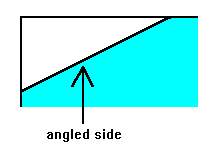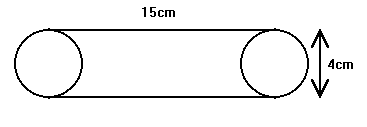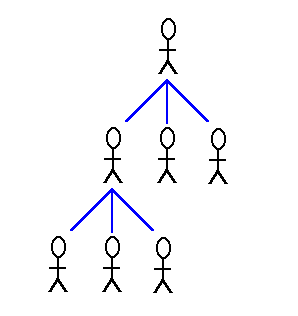Hints:
1) If Elizabeth walks 2 km/h uphill, 6 km/h downhill, and 3 km/h on level ground, how long does she take to walk througout each of the different levels?
2) What is the total distance she walks at this rate?
Hints:
1) What is the area of a circle?
2) How many circles or half circles can you see in the figure?
3) Label your different circles. How would you be able to find the shaded area using the labelled circles?
Hints:
1) You know the area of the shaded region. So how would you compute the area of the unshaded region?
Hints:
1) What portion of the tank is filled?
2) What is the volume of this portion?
3) Does the volume change when it is turned horizontal?
4) What is the depth?
Hints:
1) Let a variable t = time it takes Alex to run 1000m, Fred to run 800m and Thomas to run 600m. How fast do each of them run?
2) If Fred runs another 200m to the fimish line, how long does it take him?
3) How far does Thomas run in this time?
4) How far behind is he?
5) Setting up a table may help you. Maybe something like:
Alex Fred Thomas
----------------------------------------------------------------
Distance 1000m 800m 600m
Rate 1000/x 800/x 600/x
Time it
takes to 0 200m*x/800 ?
finish
etc.
Hints:
1) How many degrees are there in a triangle?
2) There are 180 degrees in a triangle.
3. How many right angles does a square have? (A right angle is an angle equal to 90 degrees)
4) What is the measure of the angles in an equilateral triangle. Remember, all angles in an equilateral traingle are equal.
5) Now lable the different angles, what is the measure of < BFC?
Hints:
1) Make a list of the different possible sums. Calculate the sums and cross out any sums that are replicates.
2) Start with the number one. How many possible sums are there? Continue in this way.
Hints:
1) What does it mean to be trisected?
2) If each side is trisected, what is the lengths of each section?
3) To find the lengths of the angled sides,

You must use the pythagorean theorem. (The length of the hypoteneuse is equal to the square root of sum of the squares of the other two sides).
Hints:
1) Draw a chart like the following to help you:
Before After Correct?
-----+---------+------+------+----------
| Girls | 10 | 2 |
1 +---------+------+------+ No
| Boys | 10 | 10 |
-----+---------+------+------+----------
| Girls | 20 | 12 |
2 +---------+------+------+ No
| Boys | 20 | 20 |
-----+---------+------+------+----------
Hints:
1) How would you find the average of 8 exams?
2) But you already know the average of 7 exams, so what is the average of 8 exams?
Hints:
1) Try to draw yourself a diagram of a pulley system.
2) Your diagram should look like:

Using the diagram, how long should your fan belt be?
Hints:
1) Could you have 4 quarters or 3 quarters and the rest of the coins are nickels and dimes?
2) How many quarters could you have?
Nickels? Dimes?
3) Now that you know how many coins you can have, what are the probabilities of losing a quarter, a nickel or a dime?
4. Which coin did she probably lose?
Hints:
1) Try setting up a table and work backwards to find out how many peanuts each of them started out with
t | Joe | Nick | Tom
----------+----------+----------+----------
4 | 16 | 16 | 16
3 | : | : | :
2 | : | : | :
1 | : | : | :
Hints:
1) Could there have only been 5 A's given?
2) Is it possible that there were 6 or more A's given?
3) What is the minimum number of students that received an A?
Hints:
1) Did Bart buy more 30 cent candies than 35 cent candies?
2) Let a variable equal the number of 30 cent candy.
x = # of 30 cent candy
What else does the variable x equal?
3) Solve for X according to the previous information.
Hints:
1) Try and draw a flow chart to explain how the telephone system works.

2) How many people have to do the calling in order for 100 people to be called?
Hints:
1) If all students contributed how much would each student have to pay?
2) If 15 students didn't contribute, how much money would be left to distribute among the rest of the students?
3) How much would the remaining students have left to pay?
4) If you find it difficult to work with variables, try using numbers in place of the variables and then you may have a better understanding of the question.
Example: let s = 20 students
d = $100.00
-> you should find that the remaining 5 students have to pay an
additional $15.00 each.
-> now try using variables.
Hints:
1) Can 1002 be in column b?
2) Can 1002 be in column d?
3) What do you notice about all the numbers in column c? Can 1002 be in this column?
4) Since 1002 can't be in column b,c or d, it must be in column a or e.
5) The numbers in a can be defined as 2 = 8 x where x can equal 1, 2,3...6. What can the numbers in e be defined as?
7) Set 2 + 8x = 1002 and 6 + 8 x = 1002. Whick x is a whole number? Therefore, which column is the number 1002 located in?
Hints:
1) What does B equal in terms of A?
2) Can A = 1 amd 5B3 is still divisible by 3? Can A = 5? Can A = 4?
What is the highest possible value for A? B = A + 2 + 1
Hints:
1) If you have a right triangle (90 degrees) how do you find the side opposite the right angle?
2) What is the length of bc if you know the
Hints:
1) What is the formula for the area of a triangle?
2) What is the length of the base? The length is the change in x !
3) What is the height of the triangle? The height is the change in y!
4) What is the area?
Hints:
1) How far did Constable Bob travel?
2) Remember rate or speed equals distance divided by time.
3) If you know how far Bob travelled in 10s, then how far did Melissa
travel in this time?
4) What was Melissa's speed, if you know the distance she travelled and
the time?
Hints:
NONE!!!
Hints:
1) How do you find the average of 4 numbers?
2) If you don't know one of the numbers, set that unknown equal to a
variable (x).
3) Set up the usual equation to find the average and solve for the
variable x.
Hints:
1) You have two equations. Try using one equation to find the value of x.
2) Now use another equation to find the value of k.
Hints:
1) Could her age be in the teens?
2) Could her age be in the twenties?
3) Could her age be in the thirties?
4) What about the forties?
Hints:
1) How many kilometers can he go with a full tank of gas?
2) How many times does he have stop?
Hints:
1) This is a trial and error problem. You have to write down your
information to try and solve the problem.
2) What is the square root of 104?
Hints:
1) How much money would Charlene's Mom have earned if she had continued
to work for the dealer for the last 3 weeks?
2) If you know how much she could earn in 3 weeks, then how much could
she earn in 4 weeks? (Use a proportion) 3. How much was the bike
worth?
Hints:
1) What is the volume of the waterbed? Therefore, what is the weight of
the water?
Hints:
1) Can the number 4 be written in exponential form?
2) We know that 23 = 8 so what does 24 equal?
3) When you multiply exponential numbers with the same base, what do you
do with the exponents? 4. So, what is the value of (4)(21996)?
Hints:
1) What is the sum of the sides of the triangle?
2) Does this tell you anything?
3) Do the sum of the two sides of a triangle have to be greater or less
than the length of the other?
Hints:
1) What percentage of homes contain only one person?
2) 25% of the homes containing one person contain a male. Then what
percent of the homes contain a female?
Hints:
1) How many students actually voted?
2) If 90% of the total number of students voted then what is the total
number of students in the school?
Hints:
1) If you are having trouble, try drawing this figure on a piece of
paper and cutting it out.
Hints:
1) Let a, b, c and d be your four different numbers.
2) Then a + 3 = b - 3 = ? = ? (Fill in the question marks)
Let them all equal a variable x.
3) What does x equal in terms of a, b, c and d?
4) a + b + c + d =64 (In terms of x what does this equation look like?
5) What does x equal? What do a, b, c and d equal?
6) What is the difference between a and b?
Hints:
1) Rearrange the expressions so that the conditions are met.
Hints:
1) How many jerseys have numbers between 10 -> 20?
2) How many between 20 -> 30?
3) Therefore, seeing the pattern, how many 2 digit numbers can you have?
4) If 1 and 2 are not allowed as single digits, then how many single
digit jerseys are allowed to be made?
Hints:
1) If Jean-Martin spends x amount of money, then how much does Mark spend?
2) Two times the amount of money Mark has left, equals the amount
Jean-Martin has left.
3) If Jean-Martin has 3.00 - x left, how much does Mark have?
4) Solve your algebraic equation for x.
Hints:
1) Remember that rate = distance/time
2) How far did the motorcycle travel?
3) How far did the truck travel?
Hints:
1) When you have found the areas of the rectangles, what do you notice?
2) What is the sum of the smallest rectangles equal to?
3) Can you see a relationship?
Hints:
1) What are the properties of an equilateral triangle?
2) What is the length of AR?
3) Using the Pythagorean Theorem, What is the length of QA? Therefore,
what is the length of BA?
4) Again, using the pythagorean theorem, what is the length of PB?
Hints:
1) If I sold 2/3 of my pencils, what fraction of my pencils do I have left?
2) Let the total number of pencils be a variable x. Therefore how many
pencils do I have? 3. How much money did I make?
Hints:
1) What is the circumference of the clock?
2) How far would the hand travel in 30 minutes?
3) How far would the hand travel in 5 minutes?
4) Therefore, how far would the hand travel in 35 minutes?
Hints:
1) If the denominator is x, then what is the numerator?
2) If the numerator is tripled, what does it become?
3) If the denominator is increased by 7, we know that it will become x + 7.
4) Set up the algebraic equation, cross multiply and solve for x.
5) Remember that x is your denominator, so what is the resulting fraction?
Hints:
1) If x is the amount of peanut butter cups he ate the first day, then
how many did he eat the 2nd day?
2) How many did he eat the 3rd day? 4th day? 5th day?
3) Add the amount of cups he ate on all five days and equate it to 100
(which is the total amount). Solve for x.
Hints:
1) How would you get the number 10 from the number 2 or the number 202
from the number 10?
2) If you square the first number and add two, do you get the correct
sequence?
3) What about if you square the first number and multiply by two?
4) What are you missing?
Hints:
1) What is one hundred and one in roman numerals?
2) What did the boy learn?
Hints:
1) One of the properties of a magic square which you have learned or
will learn this year is that the numbers in the square are consecutive.
For example:
have numbers 1, 2, 3, 4, 5, 6, 7, 8, 9,
2) So what numbers must be in this square?
36, 38, 39, 40, 41, 42, 43.
3) What is the magic square sum?
Hints:
1) What is the surface area of the diamond facing you? What is the
length of one of its sides? (HINT: use the pythagorean theorem).
2) How many diamonds are there in a cuboctohedron?
What is the total suface area of the diamonds?
3) What shape are the other faces (other than the diamonds)?
4) What is the height of the triangle (use the pythagorean theorem)?
What is its area?
5) What is the surface area of all the triangles?
6) What is the total surface area?
Question #21
Question #22
Question #23
Question #24
Question #25
x2 + k = 7x + 15
or
x2 + k = 3x + 7
Question #26
Question #27
Question #28
Question #29
Question #30
Question #31
Question #32
Question #33
Question #34
Question #35
Question #36
Question #37
Question #38
Question #39
Question #40
Question #41
Question #42
Question #43
Question #44
Question #45
Question #46
Question #47
Question #48
Question #49
2 | 9 | 4
-----+-----+-----
7 | 5 | 3 have numbers 1, 2, 3, 4, 5, 6, 7, 8, 9,
-----+-----+-----
6 | 1 | 8
Question #50